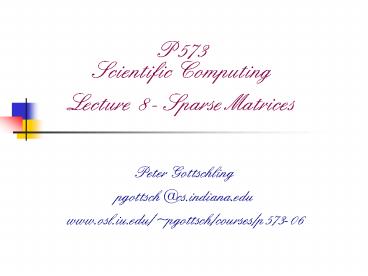P573 Scientific Computing Lecture 8 Sparse Matrices - PowerPoint PPT Presentation
1 / 16
Title:
P573 Scientific Computing Lecture 8 Sparse Matrices
Description:
Matrix of 2D-Poisson Equation. Off-diagonals with non-zeros only doesn't need to stored ... For 9 9-Matrix of Poisson example. We know the matrix already why we ... – PowerPoint PPT presentation
Number of Views:82
Avg rating:3.0/5.0
Title: P573 Scientific Computing Lecture 8 Sparse Matrices
1
P573Scientific ComputingLecture 8 - Sparse
Matrices
- Peter Gottschling
- pgottsch_at_cs.indiana.edu
- www.osl.iu.edu/pgottsch/courses/p573-06
2
Overview
- Structured sparse matrices
- Band matrices
- Matrix vector product
- Unstructured matrices
- Matrix vector product
- Other operations
- Insertion
3
Tridiagonal Matrices
- Diagonal and off-diagonals are only non-zero
- For instance 1D-Poisson equation
- Can be stored as vectors
4
Band Matrices
- Extension of tridiagonal matrices
- An (l, u)-m?n band matrices has
- Only non-zeros in l diagonals below the main
diagonal - Only non-zeros in u diagonals above the main
diagonal - Formally
5
Matrix of 2D-Poisson Equation
- Off-diagonals with non-zeros only doesnt need to
stored - Instead of 0 diagonals we store offsets of
non-zero off-diagonals - In example of 3x3 domain -3, -1, 0, 1, 3
o0, ..., on
6
Matrix Vector Multiplication yAx
- struct_matrixmult (const vector x, vector y)
- for (int i 0 i lt max(-off0, 0) i)
- for (int j 0 j lt n j)
- if (ioffj gt 0) yi aij
xioffj - for (int i max(-off0, 0) i lt min(N,
N-offn-1) i) - for (int j 0 j lt n j)
- yi aij xioffj
- for (int i min (N, N-offn-1).)
- Why can ifs be expensive?
7
Matrix-free Matrix Vector Multiplication
- For 9?9-Matrix of Poisson example
- We know the matrix already why we need to store
it? - sample_matrixmult (const vector x, vector y)
- for (int i 0 i lt 9 i)
- yi 4.0xi
- if (i gt 2) yi -1.0xi-3 //
northern neig. 2D - if (i lt 7) yi - xi3 //
southern neig. in 2D - if (i 3) yi - xi-1 //
western neig. in 2D - if ((i2) 3) yi - xi1 //
eastern neig in 2D
8
Unstructured Matrices
- If there is no structure or to hard to explore
- For all non-zeros, row, column and value need to
be stored - Somehow
- Example 77-Matrix in picture (0,0,1), (0,5,2),
(1,1,3), ... - Which options we have to store this information?
- Can we save some memory?
9
Coordinate Matrix
- Use one vector for each elements row, column and
value - Vector length is number of non-zeros
- Which advantages and disadvantages has this
format?
10
CRS Format
- Compressed Row Storage (sometimes CSR)
- rowi first non-zero in row i (0...6N-1)
- rowN nnz past-end index
- columnk column of k-th non-zero
- aijk value of k-th non-zero
11
yAx with Compressed Rows
- crs_matrixmult (const vector x, vector y)
- for (int i 0 i lt N i)
- yi 0
- for (int n rowi, next rowi1 n lt
next n) - yi aijn xcolumnn
12
Possible Performance Improvements
- Unroll outer loop
- More independent operations
- Unrolling inner loop only useful if enough
non-zero per row - Temporary variable avoids cache invalidation
- crs_matrixmult (const vector x, vector y)
- for (int i 0 i lt N i)
- temp 0
- for (int n rowi, next rowi1 n lt
next n) - temp aijn xcolumnn
- yi temp
13
CCS Format
- Compressed Column Storage
- Sometimes CSC
- Roles of rows and columns are interchanged
- In MTL same implementation
- How would you implement a matrix vector product
with this format?
14
Matrix Product vs. Matrix Vector Product
- Assume we have to multiply matrices A and B
- And some vectors, e.g. y 2ABx
- Which program fragment is more efficient?
- sparse_matrix C mult(A, B, C)
- for (int i 0 i lt 10000 i)
- C.mult(x, z) y 2z
- for (int i 0 i lt 10000 i)
- A.mult(x, z) B.mult(z, w) y 2w
15
Symmetric Matrices
- Store only upper triangular
- Lower is mirrored
- Adapt matrix vector product
- for (int i 0 i lt N i)
- yi 0
- for (int n rowi, next rowi1 n lt
next n) - yi aijn xcolumnn
- if (i ! columnn) ycolumnn aijn
xi - Can we traverse easily all elements in a row?
- Or in a column?
- For instance to implement matrix addition
- Same applies for anti-symmetric or Hermitian
matrices - How to generalize the implementation?
16
Summary
- Different representations
- If matrix has structure, exploit it for
performance - For unstructured matrices CRS format favorable
- Sparse matrix multiplication is rare
- Replacing by sequence of matrix vector product in
most cases better - Most important operation for sparse matrices is
matrix vector product - One of the most important components in
simulations - If not the most important performance-wise































